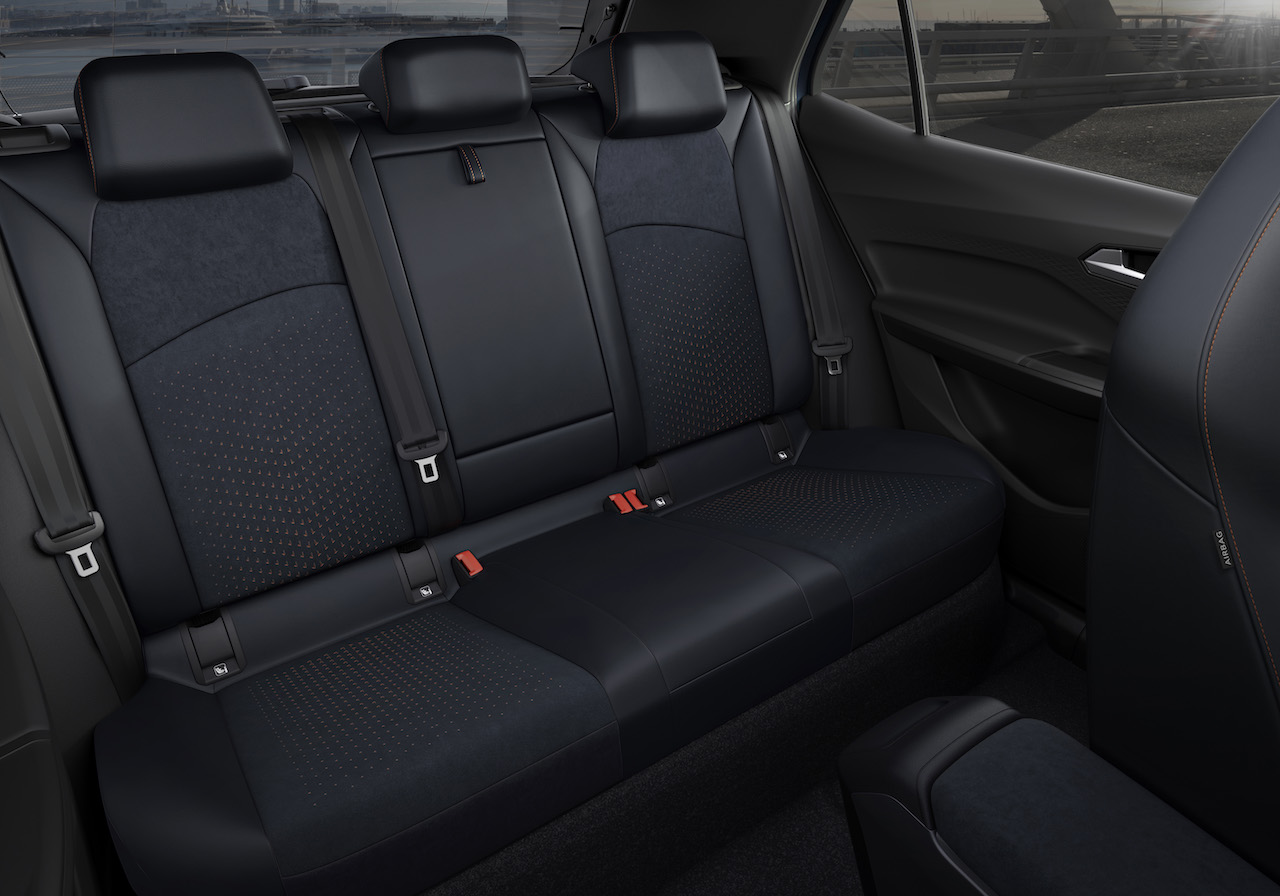
Based on the Volkswagen ID.3, the Cupra Born adds a bit of spice to a rather wise compact electric niche. Its sporty version VZ promises to captivate its driver from the top of its 230 hp. First contact.
The creators of the first electric car of the Cupra brand speak of a “Emotional driving experience”. The assertive style of the Born VZ announces in any case the color with its coppery finery, its 20-inch rims and its worked sills. In a category of electric compacts where performance takes a back seat, the Spaniard is therefore betting on dynamism.
Despite everything, its external signs of speed hardly hide its twinness with the Volkswagen ID.3, with which it shares the technique and the MEB platform. The Cupra is distinguished by its redesigned front and stern, but also by its chassis lowered by 15 mm at the front and 10 mm at the rear. The Born uses the same engines (150 and 204 hp) as the German, while the VZ version increases its level of play with a power of 230 hp thanks to an unprecedented e-boost function. With this hardware, our test compact aims to offer a more spicy temperament than that of its cousin.

Price, range and charging Cupra Born
Cupra only communicates for the moment the price of the mid-range version: 40,250 € before bonus for the V204 with 58 kWh battery. This proposal will be supported in January 2022 by an entry-level model with 150 hp and a small battery of 45 kWh. Its price is estimated at around € 35,000. At the top of the range, the 230 hp VZ will begin its career on November 21 with two battery capacities (58 kW in five places or 77 kW in four places). It will be billed at around € 45,000 (estimate) and will enrich its endowment with both sporting elements and driving aids. (see all the equipment on page 2).
The Cupra Born’s fast charging capabilities depend essentially on the battery chosen (from 50 to 170 kW in AC), while the on-board DC charger varies from 7.2 to 11 kW depending on the version (see table on next page). Our 230 hp VZ trial version has an AC on-board charger with a capacity of 11 kW. On a public terminal, you have to wait 6:30 a.m. to recover all of the 548 km of range promised by the large 77 kWh battery.
Driving

The first evolutions in town are a treat. The Cupra Born feels at home there, and its 1.81 m wide is no problem. Its sloping hood and reduced turning radius enhance its agility in urban environments. With the Comfort driving mode and optional controlled damping that equips our test model (850 €), the ability to absorb speed bumps and other retarders spares the vertebrae of the front passengers, less those of the rear occupants. As always, electric propulsion loves this environment. The smoothness contributes to the pleasure of driving, and the 310 Nm of torque available without delay allow rapid reactions. Unlike many rivals, the Born is content with two engine braking modes: freewheel in D mode more or less marked depending on the driving program and more accentuated deceleration in position B. The latter always requires the driver to apply braking. the lack of attack implies a minimum of habituation.
Compared to the 204 hp version, the VZ includes a Boost mode which offers an additional 20 kW and carries power at 230 hp for thirty seconds if the battery condition permits. It is activated in the event of a kick down or after having opted for the Cupra driving mode. Relaunches and acceleration are then expeditious, even if the effect is less impressive beyond 110 km / h. Well helped here by its large battery with a capacity of 77 kWh, the Born discovered a vocation as a traveler and can travel 400 km in one go. Its consumption of 15.4 kWh on a road trip promises to be reasonable. They allow you to enjoy its conciliating damping for longer and a silence interrupted by a few rolling noises.

Given the promises of its parents, the Cupra Born is expected at the turn. In its Range and Comfort driving modes, the dynamism is not up to expectations. The steering as light as it is silent and the vertical movements which penalize the precision of control do not encourage to increase the pace. On the Cupra program, its ability to turn flat is more of an illusion. Except that the Born still lacks enthusiasm for registration and ends up widening the trajectory under the high surveillance of an authoritarian ESP. Those looking for a pleasure close to that of the benchmark compacts should opt for the Firestorm 20-inch rim pack, with performance tires and controlled damping. By swapping the traditional 215 mm wide tires for 235 mm Michelin Pilot Sport tires and taking advantage of a fully disconnectable ESP, the car gains in precision and agility to finally live up to what we are looking for. expects from a Cupra.
On board

The interior looks like the ID.3, more rewarding. La Born justifies its premium label of the Seat brand by its more polished materials, resulting from the recycling. The now flattering presentation becomes sportier, especially after having checked the option of electric bucket seats, heated and massage covered with Dynamica suede. The serious adjustments are flattering and the many practicalities abound on board. The 5.3-inch digital cockpit, which brings together essential information in front of the driver, adds a technological touch, in particular thanks to the head-up display with augmented reality (optional).
In the center of the passenger compartment, the 12-inch touch screen brings together all the entertainment functions, but also the air conditioning, free of any button. This bias purifies the dashboard as much as it complicates ergonomics. The driver must constantly take his eyes off the road and navigate through the many menus and other submenus to adjust temperature, ventilation or find a specific setting in the multitude of driving aids. Often difficult to handle, the steering wheel with capacitive keys does not help matters. In short, ergonomics and pragmatism, that’s not it.


The Born uses its massive 2.77m wheelbase to treat its rear passengers with deference. Legroom and generous headroom allow taller riders to feel comfortable. Although the floor is raised compared to that of a conventional thermal compact, occupants do not suffer from having their legs installed too high. Only the imposing front seat backrests with integrated headrests that obstruct their visual field can interfere with the most claustrophobic. Comparable to that of a Volkswagen Golf, the 385 l trunk allows you to see coming. It has a double bottom to accommodate the Mode 2 charging cable for household outlet, after spending € 360 via a Cargo pack. A bit mean on a vehicle billed at around € 45,000.
Competetion
Despite its sportier positioning and superior power, the Born VZ is closely reminiscent of the Volkswagen ID.3, with a Latin personality. Faced with the 204 hp Born V, the first cousin offers strictly identical services and a 58 kWh battery (ID.3 Pro Performance) for € 370 less. Charged € 43,710, its Pro S version is still content with 204 hp, but it has the same large battery (77 kWh) as the more upscale Born VZ.
Scheduled for March 2022, the Renault Mégane E-Tech in its high-end version will compete with the Born VZ. As its name suggests, the EV 60 Optimum version includes a battery with a capacity of 60 kWh which accepts a higher charging power in alternating current (22 kW) and substantially comparable on the fast terminals (130 kW). Its range of 420 km is close to that of the VZ 230 58 kWh, and its power of 220 hp should guarantee comparable performance. The main difference lies in its more crossover style than that of the Cupra.
Find the test report, equipment prices and technical sheets on the next page.

















